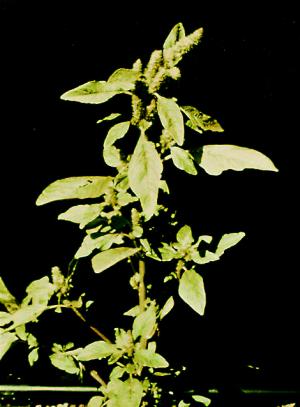CONTENTS
Registerd Herbicides
[Return to weed
Identification]
[Return to Weed
Management]
[Home] |
|

General Description:
- grows upright to a height of 2-3 feet, with hairy
upper stems.
- reddish coloring on lower stems and taproot.
- leaves are alternate and simple.
- reddish-green leaves with long petioles and prominent
veins.
- small, green flowers arranged in dense terminal
clusters (small clusters may be present in leaf axils).
- acts as a host for the beet leafhopper.
Life cycle: summer
annual
- seeds are glossy, black, and rounded with convex sides
- produced late summer through fall.
- reproduction is only by seed.
- germination - spring through summer.
Seedlings: cotyledons are narrow and pointed with a bright red underside.
Impact on Yield:
- In one study, a redroot pigweed infestation of 10
plants per square foot caused a peppermint oil yield reduction of 34.3 lbs per acre (Ian
Heap).
Habitat/ Distribution:
- throughout western states in crops associated with
cultivated soils, gardens, and waste areas.
- especially abundant in warm climates.
- introduced from tropical America.
Herbicide Control Notes:
- Goal usually not persistent enough to provide adequate
control, and higher rates often cause crop injury. Sinbar will control nonresistant
strains. Gramoxone cannot be used in actively growing mint. Tough provides the most
effective postemergence control.
|